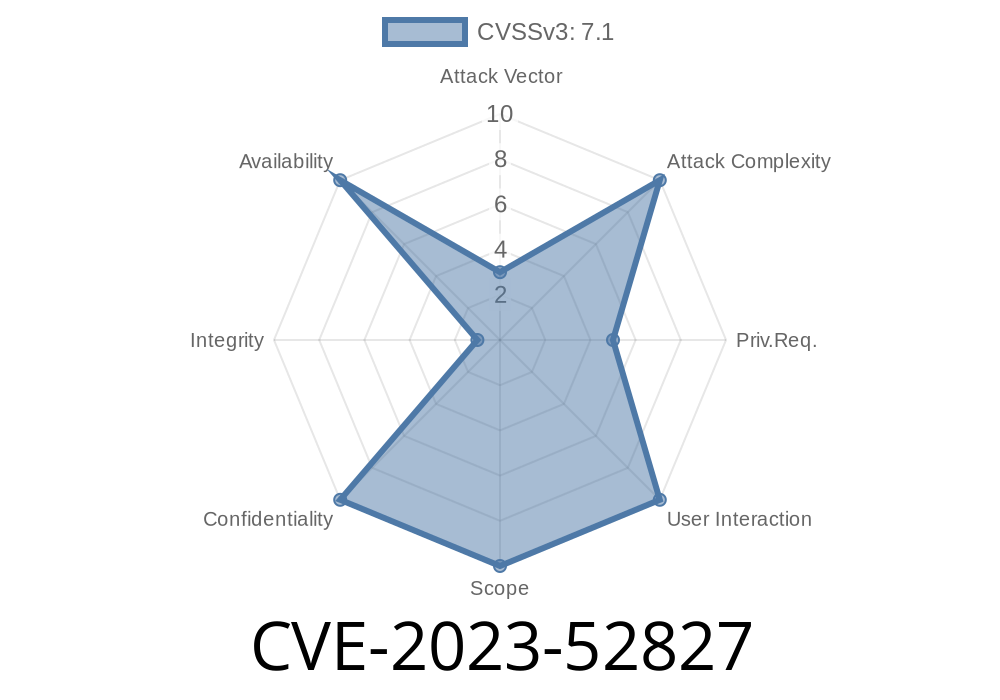Recently, a security vulnerability labeled CVE-2023-52827 was found and fixed in the Linux kernel’s ath12k Wi-Fi driver. This flaw could allow an attacker to make the system read data past the end of a memory buffer, which can potentially lead to a crash or, in rare cases, information leaks.
In this post, we break down what went wrong, how it was fixed, and provide all the technical resources you need to understand and test it, even if you're not a deep kernel expert.
What is ath12k?
The ath12k driver is for Qualcomm's 802.11ax (Wi-Fi 6E/7) chipsets. This driver handles complex messages from the Wi-Fi hardware, parsing them in the Linux kernel.
The Vulnerability: Unsafe Length Handling
Inside the ath12k driver's code, there’s a function called ath12k_htt_pull_ppdu_stats(). This function pulls statistical information out of messages received from Wi-Fi hardware (HTT messages).
A field called len tells the function how much data to read for a section.
- There’s also a num_users field (ppdu_info->ppdu_stats.common.num_users), supposed to count the number of users/devices in a packet.
The Bug:
No checks were performed to confirm that these fields are believable or within the memory buffer limits before the code used them to iterate and read data. If the driver received bad or malicious data and len or num_users was too big, it could cause the code to read past the buffer’s end—an "out-of-bounds read".
Here’s a simplified version of what the buggy code looked like
// Pseudo-code
len = extract_length_from_message(msg); // Value takes directly from input
// ... no len check ...
for (i = ; i < len; i++) {
ptr = next_item(ptr); // May read out of bounds!
}
And for num_users
num_users = ppdu_info->ppdu_stats.common.num_users; // From message too
// ... no num_users check ...
for (j = ; j < num_users; j++) {
read_user_stats(...);
}
The Fix
A patch added validation checks so that if len or num_users is too high—more than what the buffer/structure allows—the function will bail out early rather than risking an unsafe memory read.
Here’s how the improved version would look
#define MAX_USERS 32
#define MAX_MSG_LEN 4096
len = extract_length_from_message(msg);
if (len < || len > MAX_MSG_LEN) {
return -EINVAL; // Bad input
}
for (i = ; i < len; i++) {
// Safely proceed
}
num_users = ppdu_info->ppdu_stats.common.num_users;
if (num_users < || num_users > MAX_USERS) {
return -EINVAL; // Bad input
}
for (j = ; j < num_users; j++) {
// Safely proceed
}
You can see the actual patch submitted on the Linux kernel mailing list
How Bad Was It? (Exploit Details)
Impact:
An attacker with the ability to send crafted Wi-Fi data directly to the device (like a nearby device or specially crafted Wi-Fi traffic) could trigger these reads. Most likely outcomes are kernel crashes (DoS) or possible info-leak if the attacker can observe leaked data, although actual exploitability is limited due to the "read-only" nature.
Example: Crafting and Sending a Malicious HTT Message
# This is a conceptual example, not working code!
# Requires the ability to inject raw HTT packets.
malicious_msg = build_htt_message(
length=10000, # much bigger than actual buffer
num_users=100, # absurdly large
data=payload_to_trigger_bug()
)
send_to_wifi_driver(malicious_msg)
In practice, sending such a message would require physical proximity, compatible Qualcomm Wi-Fi hardware, and low-level driver knowledge.
References and Further Reading
- CVE-2023-52827 entry on Mitre
- Linux Kernel Patch commit log
- Linux Wireless Mailing List Discussion (LKML)
Practical Mitigation
If you use Linux with ath12k hardware:
Summary
*CVE-2023-52827* silently reminds us how critical memory checks are in driver code. The fix is in—the validation of input lengths stops out-of-bounds reads before they happen, keeping your system safer against malicious Wi-Fi traffic.
Timeline
Published on: 05/21/2024 16:15:20 UTC
Last modified on: 05/24/2024 01:14:46 UTC
